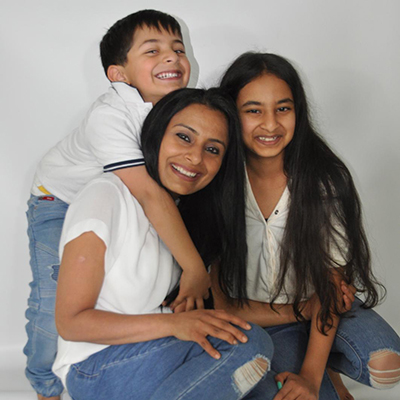A journey of hope and courage
By Shazia Haider
A stroke can happen to anybody. I am a prime example of that.
At 40 years old, I was an active, and working, mum, I was in touch with my body and aware of what I could push my body to do. I lived an active and healthy life, but I was unaware of a history stroke in my family. And I was a long-term sufferer of migraines, so I lived most days with a dull ache in my head.
It was evening in August 2018 when I suddenly felt very dizzy. I couldn’t even stand without support; I grabbed the wall trying to keep my balance.
My husband could see something was wrong and immediately called an ambulance.
It turns out that I had suffered a Haemorrhagic stroke, a bleed, in the left side of my brain.
Doctors suspect the stroke was caused by stress and high blood pressure. In the hospital’s stroke unit, the treating team gave me medicine to control my blood pressure and continued to monitor my bleeding with CT scans and MRIs.
I did get a reason for my stroke; it turns out that I had a tumour on my Adrenal gland which I had surgery to remove. Although it was scary, I am glad that I had an answer to why.
The stroke has affected the feelings and sensations on the right side of my body which impacts my daily life. Even though it has been a few years, I still have weak motor skills, debilitating fatigue, numbness, and almost no sensation at all on my right side.
These issues mean that I have had to relearn how to take care of myself, which is devastating because I have always been the carer for my family. Now I need rehab specialist visiting me at home and regular occupational and physical therapy.
Am I surviving? - Yes, in the sense that my heart keeps beating and my blood keeps pumping.
But if you can imagine a haemorrhagic stroke is like being punched hard in the brain. A strike which leaves it bruised and bloody - your brain goes into shock and some of it dies.
There are challenges to survival when your central engine has taken a beating like that.
After my stroke, I had to re-evaluate my life, and what matters most to me which is my family and loved ones.
I have made conscious choices of how to best maintain a healthy lifestyle for myself and my family, and to control risk factors. I have upped my exercise routine to about four days a week. I was not a ‘fitness person’ before my stroke, but now it is an important part of my life. I have learned to eat the right food, adjusted the way I cook for my family and visit my GP for regular check-ups.
I hope that over time, these minor changes can add up to the difference between not having a stroke and having one.
It has been a few years, but I still have no sensation on my right side and trouble doing everyday tasks.
As a mother of 12-year-old daughter and a 7-year-old son, I face challenges every day when caring for my family. Preparing meals is especially hard; stirring, cutting, using my right hand for grabbing things from oven, sometimes I burn myself. And I am in constant chronic pain.
But I am here, I am a loving mum, wife, and daughter. My children are happy, healthy and are my driving force. I am also back in the workforce, doing Human Resources and recruitment which was one of my goals. I feel appreciated and supported at the company and look forward to seeing what I can achieve. I am grateful for a second chance at life.
I have chosen to share my story because I want to help and encourage people around me to understand that stroke can happen to anyone, at anytime and anywhere.
Everyone needs to know the signs of a stroke and what to call triple 000 immediately.
People should know their risks of stroke, whether it is family history or high blood pressure.
Luckily diagnosing high blood pressure is a simple procedure which can be done at your GP or your local pharmacy in about five minutes.
It is five minutes which could prevent a stroke.

